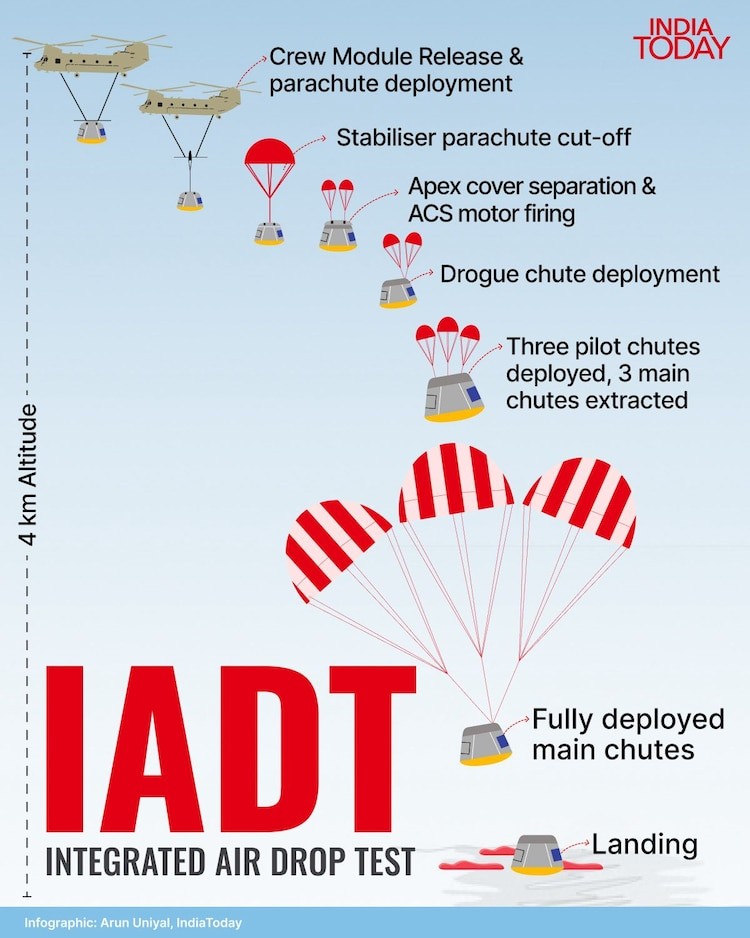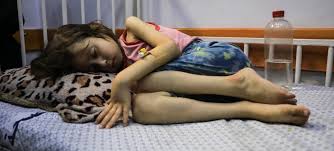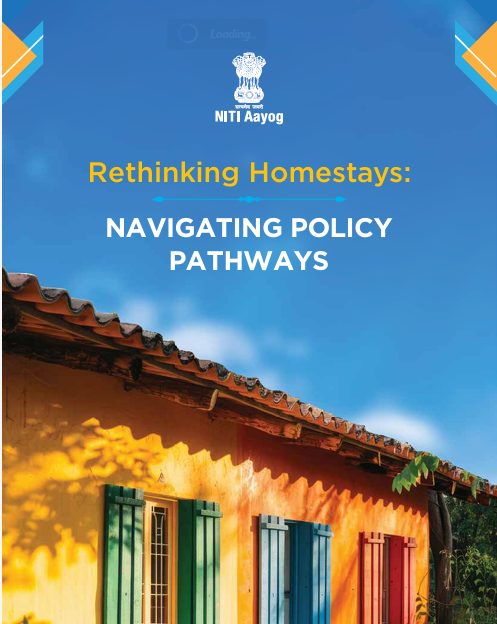ISRO Integrated Air Drop Test (IADT-01)

- 28 Aug 2025
In News:
The Indian Space Research Organisation (ISRO)has successfully conducted its firstIntegrated Air Drop Test (IADT-01) for the Gaganyaan human spaceflight programme, marking a critical milestone in validating astronaut safety systems.
Objective of IADT-01
- Test the end-to-end parachute recovery system of the Gaganyaan crew module.
- Demonstrate reliability, sequencing, and redundancy of drogue, pilot, and main parachutes for controlled deceleration and safe splashdown.
- Ensure astronaut safety during the re-entry and landing phases, considered the riskiest part of any human space mission.
Significance
- Validates a vital safety mechanism for Gaganyaan, boosting confidence ahead of upcoming missions like Test Vehicle-D2 (TV-D2) and the first uncrewedGaganyaan mission (G1).
- Strengthens India’s human-rating capabilities, positioning the country to become the fourth nation with independent crewed spaceflight capability.
- Reflects successful inter-agency collaboration among ISRO, Indian Air Force, DRDO, Navy, and Coast Guard.
Gaganyaan Mission Overview
- Crewed mission scheduled for 2028; uncrewed test flight planned in December 2025.
- Mission profile: Carry a three-member crew to low Earth orbit (~400 km) for up to three days, followed by safe return.
- The programme emphasizes astronaut safety, technological reliability, and operational preparedness, with future tests including additional parachute validations, pad abort trials, and sea recovery rehearsals.
Strategic Importance
- Demonstrates India’s capability in human spaceflight, enhancing its global standing in space technology.
- Paves the way for advanced crewed missions and potential applications in scientific research, space exploration, and international collaborations.
India’s Push for 27% Ethanol Blending
- 28 Aug 2025
In News:
India has announced its ambitious plan to increase ethanol blending in petrol to 27% (E27) by 2030, building upon the successful Ethanol Blended Petrol (EBP) Programme launched in 2003. This move aligns with India’s goals of energy security, environmental sustainability, and rural development.
Background and Progress
- EBP Programme: Started with 5% blending, it has grown from less than 2% a decade ago to 10% (E10) by 2022, with 20% blending (E20) projected for 2025, five years ahead of schedule.
- Ethanol Feedstocks: Primarily derived from sugarcane, maize, and surplus food grains, with an increasing push for second-generation ethanol from crop residues and agricultural waste under PM-JI-VAN Yojana.
- Energy Security: India imports nearly 88% of crude oil, spending over $120 billion annually. Ethanol blending reduces crude imports, conserves foreign exchange, and mitigates vulnerability to global price shocks.
- Environmental Goals: Ethanol blends reduce carbon monoxide and hydrocarbon emissions, supporting the National Green Mobility Strategy and India’s Net Zero 2070 commitment.
Economic and Social Benefits
- Farmer Welfare: The programme has channeled over ?1.2 lakh crore to farmers and nearly ?2 lakh crore to distilleries, providing stable markets for sugarcane, maize, and other crops.
- Rural Development: Ethanol distilleries generate employment, promote agro-industries, and reduce distress migration.
- Circular Economy Link: Second-generation ethanol initiatives convert crop residues and waste into energy, addressing stubble burning and enhancing sustainability.
Challenges and Risks
- Food Security: Rising ethanol demand strains maize and grain supplies. In 2023, a 5-million-tonne maize shortfall forced imports, affecting poultry, starch industries, and food prices.
- Water Use: Sugarcane requires 1,500–2,000 litres of water per kg of sugar, risking groundwater depletion in states like Maharashtra and Uttar Pradesh.
- Technological Issues: Higher blends can reduce fuel efficiency by 6–7% in vehicles not designed for ethanol. Adoption of Flex Fuel Vehicles is slow and more costly.
- Supply-Side Constraints: India produced 7 billion litres of ethanol in 2023 but will require over 12 billion litres by 2030. Financially stressed sugar mills and limited investment in grain-based or second-generation plants challenge scaling.
- Infrastructure Needs: Storage, transport, and fuel dispensing networks must expand nationwide to meet E27 targets.
Policy Recommendations
- Feedstock Diversification: Rapid development of second-generation ethanol from crop residues, forestry waste, and municipal solid waste.
- Consumer Incentives: Subsidies for Flex Fuel Vehicles, retrofitting existing engines, and awareness campaigns to ensure adoption.
- Public–Private Partnerships: Investment and collaboration to scale production, distribution, and technology adoption.
- Integration with Clean Energy Transition: Ethanol should complement electric mobility and green hydrogen, serving as a bridge solution for decarbonisation while more transformative technologies mature.
Famine in Gaza

- 28 Aug 2025
In News:
The United Nations has confirmed a famine in Gaza City and surrounding areas, describing it as a “failure of humanity” and a man-made disaster. The declaration follows a report by the Integrated Food Security Phase Classification (IPC), which raised food insecurity in parts of Gaza to Phase 5, the highest level, indicating catastrophic conditions of starvation, destitution, and death.
Scale of the Crisis
- Population affected: Nearly 641,000 people are facing IPC Phase 5 conditions, while 1.14 million (58% of Gaza’s population) are projected to experience emergency-level food insecurity (IPC Phase 4) between mid-August and end of September.
- Children at risk: By June 2026, 132,000 children under five may face life-threatening malnutrition.
- Mortality: Gaza’s Hamas-run health ministry reports 271 deaths due to malnutrition, including 112 children.
- Historical Context: Since 2004, IPC has officially classified only four famines, with the last one in Sudan, 2024.
Causes
The famine is described as “starvation by design” by UN officials:
- Aid Restrictions: Israel has been accused of systematically obstructing humanitarian aid. The UN estimates 600 aid trucks per day are needed, but only 300 trucks are entering daily.
- Conflict Impact: Israel launched a military campaign in response to the Hamas attack on southern Israel in October 2023, leading to mass casualties and displacement. Over 62,000 deaths have been reported in Gaza, with more than 90% of homes damaged or destroyed.
- Infrastructure Collapse: Healthcare, water, sanitation, and hygiene systems have collapsed, exacerbating malnutrition and disease.
International Response
- UN Officials:
- Secretary-General Antonio Guterres called the famine a “moral indictment” and a man-made disaster.
- UNRWA Chief Philippe Lazzarini termed it “starvation by design”.
- UN Human Rights Chief Volker Turk attributed the famine to Israel’s unlawful restriction of aid.
- Global Condemnation:
- UK Foreign Secretary David Lammy described it as a “moral outrage”.
- Humanitarian groups and UN bodies have called for an immediate, at-scale response to prevent widespread starvation.
- Israeli Position: Israel denies a policy of starvation, claiming it has allowed 2 million tons of aid since the conflict began and continues to organize humanitarian corridors and airdrops, though the UN calls these efforts insufficient and sometimes unsafe.
NITI Aayog Report on “Rethinking Homestays: Navigating Policy Pathways”

- 28 Aug 2025
In News:
NITI Aayog, in collaboration with the Internet and Mobile Association of India (IAMAI), released the report “Rethinking Homestays: Navigating Policy Pathways”. The document provides a strategic roadmap for strengthening India’s homestay and BnB sector, emphasizing its role in tourism, rural livelihoods, and cultural preservation.
Key Highlights of the Report
- Tourism & Cultural Value: Homestays offer travelers culturally immersive experiences while promoting local entrepreneurship, heritage conservation, and community participation.
- Economic Role: They serve as engines of livelihood creation, particularly in rural and semi-urban areas, fostering inclusive and sustainable growth.
- Regulatory Approach: The report calls for light-touch, transparent regulation to balance safety, consumer trust, and ease of doing business.
- Digital Integration: Strong emphasis on leveraging digital platforms for marketing, consumer engagement, and capacity building of hosts.
- Public–Private Partnerships: Collaboration with stakeholders like Airbnb, MakeMyTrip, IAMAI, ISPP, Chase India, and The Convergence Foundation was highlighted as critical for shaping a vibrant ecosystem.
- Best Practices: State-level examples from Goa, Kerala, Uttarakhand, and Uttar Pradesh showcase scalable models in policy, governance, and community-led initiatives.
- Policy Recommendations: Suggests flexible frameworks, skill development, financial access, and infrastructure support to strengthen the sector.
Significance for India
- Tourism Development – Homestays diversify India’s hospitality sector, offering authentic alternatives to conventional hotels.
- Employment Generation – Potential to create entrepreneurial opportunities for women, youth, and local communities.
- Cultural Preservation – Encourages conservation of art, craft, cuisine, and heritage while generating income.
- Rural Transformation – Helps bridge urban–rural divides by promoting community-based tourism.
- Sustainability – Supports low-impact tourism models, aligning with SDG 8 (Decent Work & Economic Growth) and SDG 11 (Sustainable Cities & Communities).
About NITI Aayog
- Established: 1 January 2015, replacing the Planning Commission.
- Chairperson: Prime Minister of India.
- Vice-Chairperson: Appointed by PM.
- Members: Full-time, part-time experts, ex-officio Union Ministers.
- Governing Council: Chief Ministers of states and LGs of UTs.
- Functions:
- Premier policy think tank for cooperative federalism.
- Provides strategic and long-term policy frameworks.
- Monitors and evaluates development programmes.
- Promotes innovation, entrepreneurship, and technology adoption.
- Coordinates between Centre, States, and global partners.
- Nature: Advisory, yet influential in shaping policies; key driver of initiatives like Aspirational Districts Programme, Atal Innovation Mission, and SDG localization.
Climate Change and Workplace Heat Stress
- 28 Aug 2025
In News:
The WHO–WMO joint report (2025), Climate Change and Workplace Heat Stress, warns that rising global temperatures are creating an unprecedented occupational health and productivity crisis. The year 2024 was the warmest on record, with global average temperatures 1.45°C above pre-industrial levels, and the decade 2015–2024 being the hottest ever recorded.
Key Findings
- Productivity Losses: Each 1°C rise in Wet-Bulb Globe Temperature (WBGT) above 20°C reduces global worker productivity by 2–3%. Sun exposure further raises WBGT by 2–3°C, amplifying risk.
- Scale of Exposure: Over 2.4 billion workers are directly exposed; annually, 22.85 million injuries, 18,970 deaths, and 2.09 million disability-adjusted life years (DALYs) are linked to workplace heat stress (ILO estimates).
- Geographical Hotspots: South Asia, Sub-Saharan Africa, and the Middle East face the highest risks. Heat stress now affects 30% of the global population seasonally or daily.
- Health Impacts: More than one-third of workers in hot conditions report physiological heat strain (hyperthermia, kidney dysfunction, dehydration, neurological problems). WHO safety guidance (1969) recommends that core body temperature during an 8-hour shift not exceed 38°C, a threshold increasingly breached.
- Climate Change Dimension: Daytime peaks of 40–50°C are becoming frequent even outside the tropics. Europe’s 2023 heatwave saw worker fatalities, showing that occupational heat stress is no longer limited to equatorial regions.
India’s Experience
In India, informal workers in brick kilns, construction, agriculture, and power looms are the most affected. Many begin work before sunrise to avoid peak heat, yet still suffer dehydration, dizziness, and lost wages as work hours shrink. Indoor workplaces with poor ventilation often become “furnaces,” leading to chronic fatigue, kidney strain, and even fatalities. By 2030, the ILO projects India could lose 34 million full-time equivalent jobs, particularly in agriculture and construction, due to heat stress.
Wider Implications
- Public Health Burden – Rising cases of heat stroke, cardiovascular collapse, and chronic kidney disease (26.2 million cases in 2020 alone) strain already weak health systems.
- Economic Losses – Developing economies face shrinking GDP as productivity drops; agriculture and construction are most vulnerable.
- Social Inequality – The poor, migrant labourers, and women are disproportionately at risk due to unsafe working conditions and lack of social protection.
- Climate Justice – Regions contributing least to emissions, like Bangladesh and Sub-Saharan Africa, suffer the harshest effects, deepening global inequities.
- Food Security – Agricultural labour productivity loss disrupts crop cycles and threatens farmer incomes, worsening hunger and malnutrition.
- Legal Burden – Rising occupational illness cases risk overwhelming compensation systems and highlight gaps in labour safety laws.
Adaptation Strategies
- Occupational Heat Action Plans: Early warning systems, rescheduling work timings, shaded shelters, and worker training.Example: The Ahmedabad Heat Action Plan (India) has reduced heatwave mortality through alerts, shelters, and training.
- Infrastructure & Technology: Cooling shelters, hydration points, and mechanisation to reduce manual strain.Example: Bangladesh’s garment sector has piloted low-cost ventilation and cooling fans, lowering worker fatigue.
- Labour Policy Reforms: Enforcing heat-index-based work-hour rules, mandatory rest breaks, and compensation for heat-linked illnesses.Example: Qatar bans outdoor work between 10 am–3:30 pm during peak summer.
- Public Health Measures: Hydration protocols, health screenings, and recognition of heat stress as an occupational disease.Example: US OSHA’s “Water–Rest–Shade” campaigninstitutionalises hydration and rest breaks.
- Global & National Coordination: Mainstreaming heat stress into ILO conventions, COP climate talks, and SDG frameworks, with climate finance support for vulnerable economies.Example: Australia integrates climate projections into mining and agriculture workplace safety standards.
